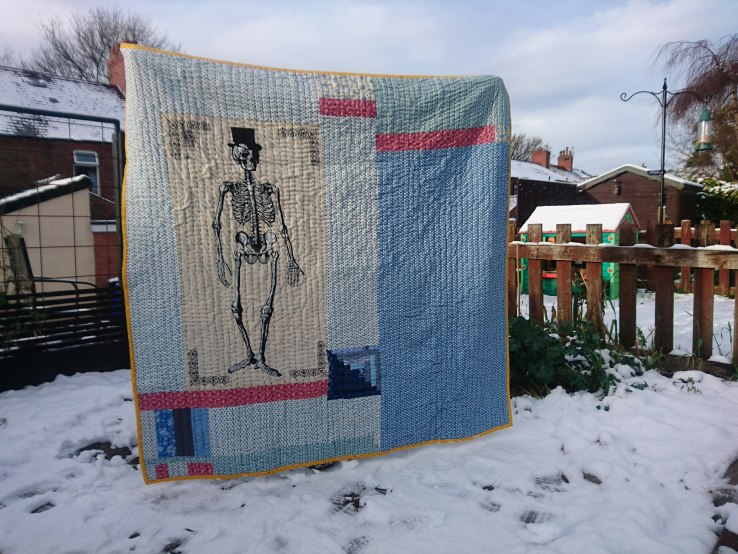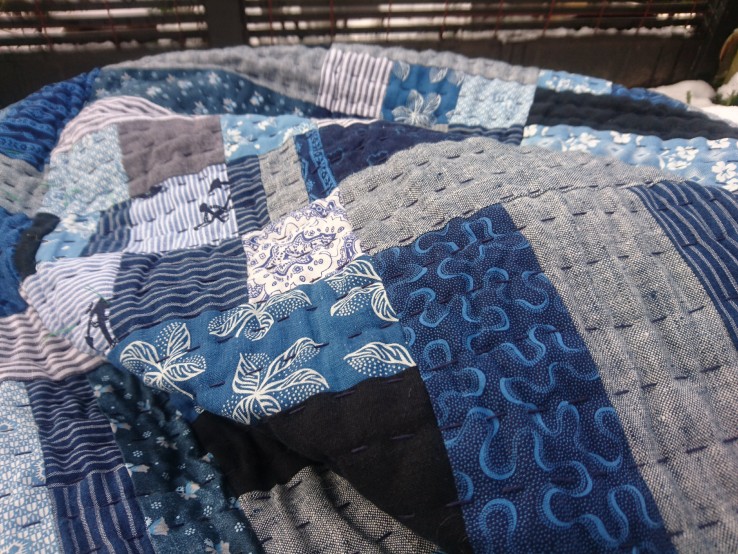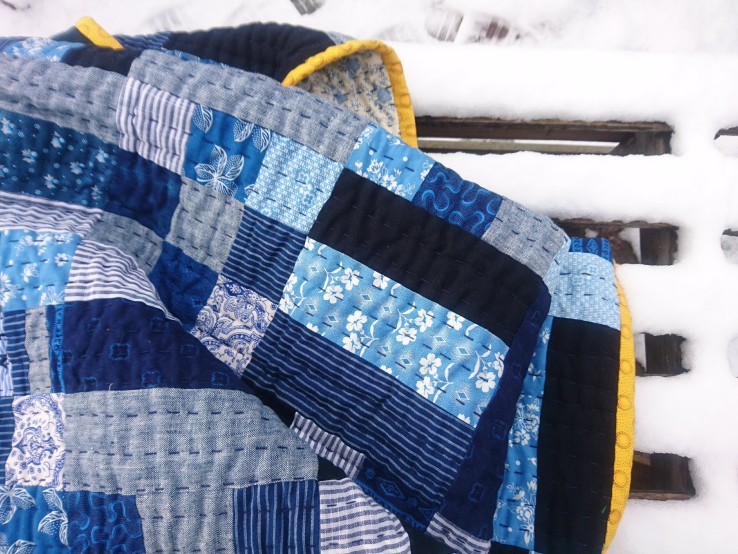Hello lovely readers – it’s been a while, hasn’t it? I hope you’re all still hanging in there and you have my deepest sympathy for any losses this past year. I’m still here, but I’ve been busy and stressed, none of which make for productive sewing time, and I’ve shied away from blogging because of the photography aspect. I’ve actually sewn a few things, but not found the energy or uncluttered space to photograph them. The house is a bit of a bombsite right now, having finally got round to starting decorating the dining room , which will hopefully give me both more space and a decent background for photographs. Here’s hoping… In the meantime, though, it just means all our stuff is in boxes and there’s no paint on the walls, so that should look great…
This quilt has also been a while in the making – I’ve been planning a rail-fence quilt for years and I’m certain this won’t be my last. I love the simple graphic nature of the pattern, which actually offers a lot of scope for variation (you can use it to make zig-zags, or a basketweave pattern, for example). It is also economical to cut, something I appreciate as a link to the origins of patchwork.
Obviously this isn’t a classic rail-rence pattern, as like most of my quilts there’s an element of ‘use what you have’. I’ve made a reasonable dent in my blue box – these are a mixture of almost new clothes I was gifted which didn’t fit me, and some hoarded pieces of vintage printed Manchester cottons. There are a fair variety of fabric weights in here – the cottons are quite fine and tightly woven, there’s some heavy linen, and the lighter blue-and-white stripe is double-gauze.
To make the blocks, I cut all my fabric into strips and pieced them together in rows 3 strips wide. I then cut these rows into squares to make the individual blocks. Often this would leave a section of 3 strips which wasn’t long enough to make a full block, so I cut these into smaller sections to make the 9-patch blocks. Without these scrap blocks I wouldn’t have had enough blocks to complete the quilt, and there were hardly any scraps left from cutting, which I was thrilled with given the irregular sizes of the original pieces of fabric (and almost complete lack of planning). There are also a couple of scrappy improv blocks in the mix, again really just to use all the fabric in the pile, but I also love the look if I’m honest!
You know I love a party in the back, and I’m not sure I could make a quilt with a completely plain back, it seems like a waste of a blank canvas! I bought *ahem* a few of these Mr Chillingsworth panels on sale a while back, and I thought using one here would add some interest to the back. The rest is improv-pieced to use up fabrics left over from other projects, together with some larger bits I don’t think shine in their own right, but blend nicely in a relaxed patchwork. The little log-cabin block is the very last of the usable scraps from the front of the quilt.
I treated myself to wool wadding, having read it’s good for hand-quilting, but also the fabrics are so soft and snuggly I wanted a wadding which would whack up the snuggle-factor. I don’t think I’ve done enough hand-quilting to have a preference for wadding (and this certainly isn’t ‘fine’ quilting), but of the projects I have done I wouldn’t say the wool was the easiest to manipulate, it has a tendency to be a bit shifty, maybe because of its high loft. It does make a wonderfully soft and warm quilt though, and I will definitely use it again, not for every quilt (it is significantly more expensive than cotton), but for quilts that seem to want it.
I used navy sashiko thread to quilt big fat stitches – I’ve definitely pulled the quilting lines too tight in some places and there are a couple of puckers in the back, but perfectionism is definitely not my thing when it comes to quilts.
I was torn between red or yellow for the binding, and to be honest I think I would have liked either equally, but when in doubt I do tend to always pic yellow. This is a printed Shwe-Shwe cotton from The African Fabric Shop (the same place I bought the vintage blue cottons, a few years ago), and I emembered to use a double-fold binding (usually I only remember after I’ve cut the binding too narrow to do this, so YAY for remembering!) I actually took the binding off and re-sewed it (yup, really). I’d read something ages ago about ‘fullness’ in bindings, and basically how it was ideal to have a full binding, so I sewing it on first with quite a large seam allowance so the biding would gather all that up and be full. Turns out I hated it – the extra bulk in the binding made it stiff in contrast with the drape of the rest of the quilt (which was extra-soft and drapey anyway with the wool batting), so after stitching down a metre of the binding I decided to take it off and re-do it. Which was not fun, but I am super-glad I did it. And at least now I know that’s another piece of quilting wisdom I can ignore – they’re adding up, for sure… I think maybe I have a different perspective on a lot of the quilting ‘rules’, having more experience with garment sewing, but whenever I read advice on how to make your points perfect, or what such-and-such a thing ‘should’ be (like the full binding), it makes me antsy. Who makes all these rules anyway? In my view a perfect quilt is one that suits you and suits its purpose. OK, rant over…
Anyway, I love this quilt so much, it’s been at the back of my mind for a few years now and had time to grow as an idea, so the actual process of putting it together didn’t take much thought or effort at all. I think all the elements have come together really well, and it’s a firm favourite for Rosie to curl up on, so a winner all round, really. I actually finished this quilt in the summer, together with a king-sized bed quilt as yet un-photographed, and since then I’ve been finishing off various small WIPs. It’s been a bitty year, but I’m looking forward to a more intentional 2021, where hopefully I’ll be able to carve out some dedicated time to sew every day. Photographs, though, well that’s a whole other thing…
Take care, and here’s to an optimistic new year,
X




